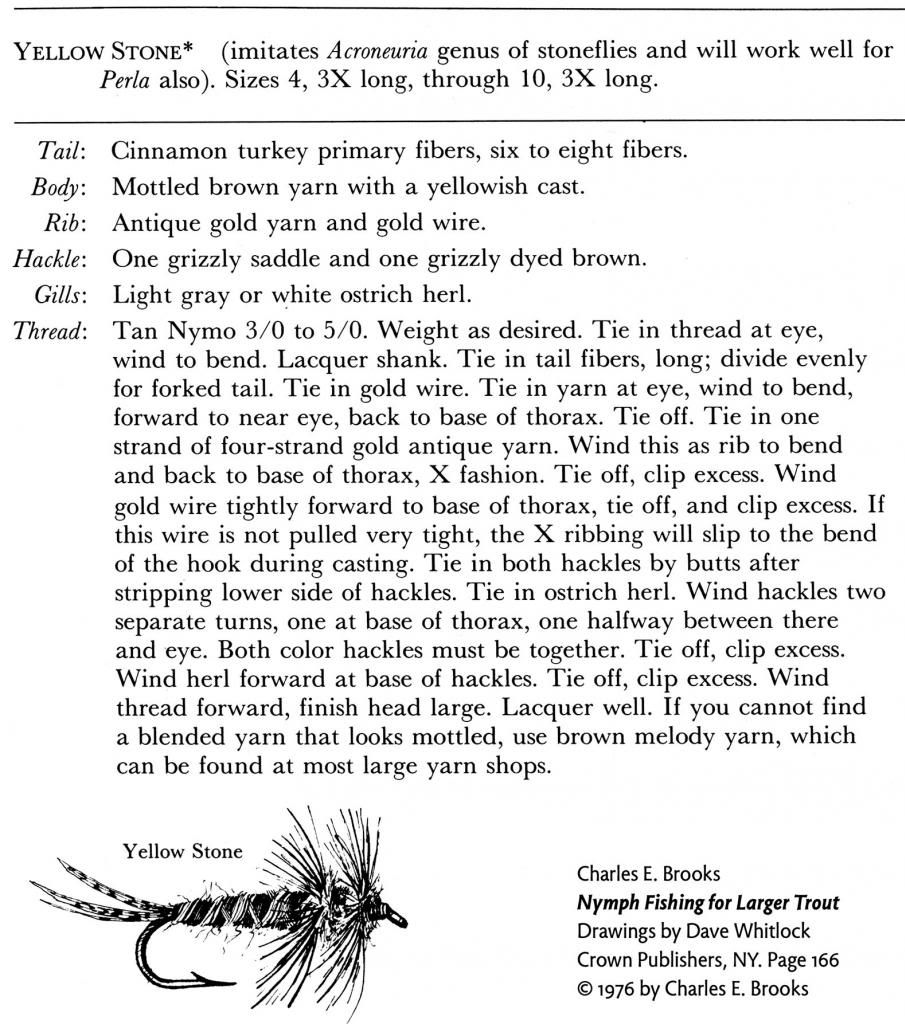
Brooks' Stonefly Nymph
Moderators: William Anderson, letumgo
Brooks' Stonefly Nymph
In some e-mail correspondence about his thread on a Golden Stonefly Nymph pattern, Lance sent me the recipe for a Charlie Brooks stonefly nymph, along with a sketch of it done by Dave Whitlock. Here is my take on it, a variation since I used variegated brown/yellow chenille in lieu of brownish yellow yarn for the body.


Last edited by tie2fish on Thu Oct 12, 2017 12:50 pm, edited 1 time in total.
Some of the same morons who throw their trash around in National parks also vote. That alone would explain the state of American politics. ~ John Gierach, "Still Life with Brook Trout"
-
DUBBN
Re: Brooks' Stonefly Nymph
Very nice interpretation.
- Soft-hackle
- Site Admin
- Posts: 1874
- Joined: Sat Feb 21, 2009 10:23 am
- Location: Wellsville, NY
Re: Brooks' Stonefly Nymph
Sweet, Bill. That should work very nicely.
Mark
Mark
"I have the highest respect for the skilled wet-fly fisherman, as he has mastered an art of very great difficulty.” Edward R. Hewitt
http://www.libstudio.com/FS&S
http://www.libstudio.com/FS&S
- William Anderson
- Site Admin
- Posts: 4569
- Joined: Mon Feb 23, 2009 3:14 pm
- Location: Ashburn, VA 20148
- Contact:
Re: Brooks' Stonefly Nymph
Nicely done. Brooks certainly understood the value of a lively flymph. Though he was right to call it a nymph as it was not actively rising to hatch...it's not hard to spot a flymph when you see one. And this interpretation is killer.
"A man should not try to eliminate his complexes, but rather come into accord with them. They are ultimately what directs his conduct in the world." Sigmund Freud.
www.WilliamsFavorite.com
www.WilliamsFavorite.com
-
Mataura mayfly
- Posts: 3648
- Joined: Thu Oct 27, 2011 6:28 am
- Location: Southland, South Island, New Zealand.
Re: Brooks' Stonefly Nymph
Usually I am not a fan of chenille- but it looks good here. Like the open wraps of the hackle- like two separate rows of legs, the colour change at the thorax and the taper of the body.
Top marks all around.
Top marks all around.
"Listen to the sound of the river and you will get a trout".... Irish proverb.
Re: Brooks' Stonefly Nymph
Hi Bill,
Nice fly and nice tying!!
You call this fly the Charlie Brooks Stonefly, but I could not find it in the two books of Brooks??
What was the book of C.Brooks??
Do you know why he could have put in the pattern the two grey herls of the oistrich on the base of the hackle?? He insisted in making flytying as simple as possible. There must be an important reason for this??
Greeting
Nice fly and nice tying!!
You call this fly the Charlie Brooks Stonefly, but I could not find it in the two books of Brooks??
What was the book of C.Brooks??
Do you know why he could have put in the pattern the two grey herls of the oistrich on the base of the hackle?? He insisted in making flytying as simple as possible. There must be an important reason for this??
Greeting
There will allways be a solution.
http://www.aflyinholland.nl
http://www.aflyinholland.nl
Re: Brooks' Stonefly Nymph
Brooks tied a black stonefly nymph to represent the Pteronarcys Californica, or giant stonefly nymph. It is tied with a black wool body and brown-dyed grizzly hackle in two separated turns, with ostrich herl at the base to represent the gills. It also has a copper wire rib and a separated tail of crow fibers, and was heavily weighted. Many of his nymphs were tied "in the round" rather than with a distinct top and bottom. Hope that helps.
- letumgo
- Site Admin
- Posts: 13346
- Joined: Sat Feb 21, 2009 7:55 pm
- Location: Buffalo, New York
- Contact:
Re: Brooks' Stonefly Nymph
Ruard - It is my understanding that the ostrich herl is included in the pattern to imitate gills on the natural insect.
Bill - I have generally seen Brook's Stonefly Nymphs tyed in black, with a yellow throrax. Terrific variation. The brown & yellow variegated chenille is a perfect choice of imitating the colors of a golden stonefly.
Bill - I have generally seen Brook's Stonefly Nymphs tyed in black, with a yellow throrax. Terrific variation. The brown & yellow variegated chenille is a perfect choice of imitating the colors of a golden stonefly.
Ray (letumgo)----<°))))))><
http://www.flytyingforum.com/index.php? ... er=letumgo
"The world is perfect. Appreciate the details." - Dean
http://www.flytyingforum.com/index.php? ... er=letumgo
"The world is perfect. Appreciate the details." - Dean
-
DUBBN
Re: Brooks' Stonefly Nymph
Thanks John. I knew the tail was not tied with goose biots, and for the life of me, I couldnt remeber what it was tied with. Thank you for clearing that up for me.JohnP wrote:Brooks tied a black stonefly nymph to represent the Pteronarcys Californica, or giant stonefly nymph. It is tied with a black wool body and brown-dyed grizzly hackle in two separated turns, with ostrich herl at the base to represent the gills. It also has a copper wire rib and a separated tail of crow fibers, and was heavily weighted. Many of his nymphs were tied "in the round" rather than with a distinct top and bottom. Hope that helps.
Re: Brooks' Stonefly Nymph
Ruard,Ruard wrote: You call this fly the Charlie Brooks Stonefly, but I could not find it in the two books of Brooks??
What was the book of C.Brooks??
Do you know why he could have put in the pattern the two grey herls of the oistrich on the base of the hackle?? He insisted in making flytying as simple as possible. There must be an important reason for this??
Here is the Charlie Brooks recipe that Bill was working from. As you can see, the gray ostrich represented gills. The asterisk indicated that this was an original Brooks pattern.
Lance

